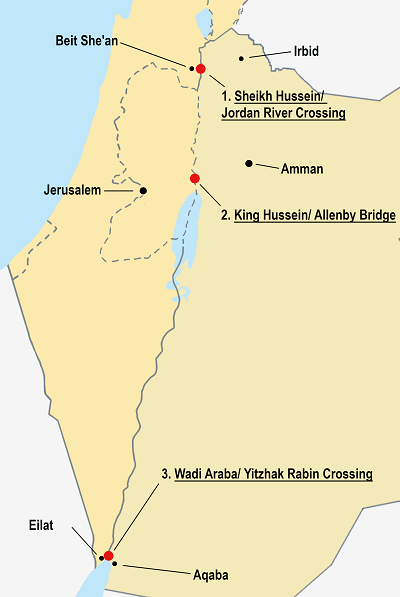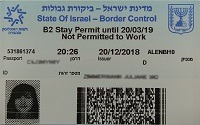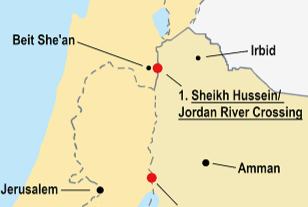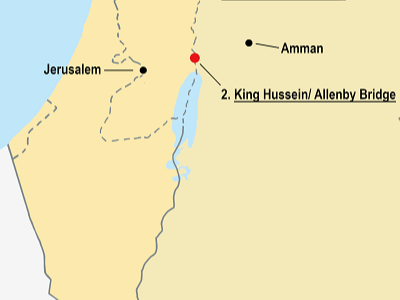Navigating the Border Crossings between Jordan and Israel/Palestine
Last Updated Date: Jan, 2025
 There are three land border crossings between Jordan and Israel/Palestine that tourists can pass. Each of them has two names – one on the Jordanian, and one on the Israeli side. From North to South, they are:
There are three land border crossings between Jordan and Israel/Palestine that tourists can pass. Each of them has two names – one on the Jordanian, and one on the Israeli side. From North to South, they are:
1. The Northern Crossing: Sheikh Hussein / Jordan River Border Crossing
Located approximately between the Jordanian city Irbid and the Israeli town Beit She’an.
2. The Central Crossing: King Hussein / Allenby Bridge Border Crossing
Located approximately between Jordan’s capital Amman and Jerusalem.
*This is the most frequented land border between Jordan and Jerusalem due to its central location.
3. The Southern Crossing: Wadi Araba / Yitzhak Rabin Border Crossing
Located close to the Red Sea, between Aqaba and Eilat.
FAQs & General Information
For information specific to each individual border crossing, see below this section.
Exit Taxes
At either side of the border, an exit tax has to be paid when leaving the country.
(IL) = Israeli-Controlled Terminal
| Border Terminal | Exit Tax (per person) |
|---|---|
| All Jordanian Terminals | 10 JOD (~$14 USD) |
| Northern Crossing: Jordan River Crossing (IL) | 117 ILS (~$35 USD) |
| Central Crossing: Allenby Bridge (IL) | 203 ILS (~$60 USD) |
| Southern Crossing: Yitzhak Rabin Crossing (IL) | 117 ILS (~$35 USD) |
Standard Shuttle
At Allenby/ King Hussein Bridge, as well as at the Jordan River/ Sheikh Hussein Crossing, you have to take a shuttle bus to cross the space between the two border terminals.
| Border Crossing | Shuttle Bus (per person) | Luggage (per piece) |
|---|---|---|
| Northern Crossing: Jordan River Crossing (IL) / Sheikh Hussein | 25 ILS/4 JOD/5.72 USD | free |
| Central Crossing: Allenby Bridge (IL) / King Hussein | 7 JOD (~$10 USD) | 1.5 JOD (~2 USD) |
VIP Service
Central Crossing: Allenby Bridge (IL) / King Hussein: $150 USD per person.
Southern Crossing: Yitzhak Rabin / Wadi Araba Crossing: 24 ILS per person (~$8 USD)
Jordan River (IL) / Sheikh Hussein Crossing:
| Number of People | Price (per person) |
|---|---|
| 1 | $71 USD |
| 2 | $54 USD |
| 3 | $48 USD |
| 4 | $45 USD |
| 5 | $43 USD |
| 6 | $42 USD |
The VIP Service is a provision run by the staff at the borders to enable faster crossing. The service includes “VIP” waiting rooms, assistance with immigration, security, and luggage; plus a private van shuttle between the terminals. Usually, clients go to the front of any queues. The VIP service can save lots of frustration, speed up the crossing considerably (especially when the border is busy), and allow more comfort.
Is the VIP Service worth the money?
Like most things, we think the answer is “it depends.” It depends on your budget, trip timeline, personal preferences, etc.
It’s not possible to travel in a rental car from Jordan to Palestine/Israel and back. However, you can park a rental car in the paid parking lots on either side of the border.
The Israeli Authorities current policy is to not stamp passports for tourist visas.
Instead, travelers are issued with a personalized printed card (see picture). You should make sure to keep this card with you throughout the duration of your stay in Israel. Do not lose it.

The entry and exit procedures for Israel/Palestine are governed by Israeli state authorities. Here’s what you need to know:
Citizens from most Western countries can obtain a visa upon arrival at several entry points, including Ben Gurion Airport, Eilat Airport, King Hussein/Allenby Bridge, Sheikh Hussein/Jordan River Crossing, or Wadi Araba/Yitzhak Rabin Crossing. If, however, you require a visa in advance, the application process should be initiated at an Israeli Embassy, typically the one in your home country.
Starting on 01.01.2025: Tourists arriving in Israel/Palestine with a passport from countries that are exempt from visas will be required to obtain an ETA-IL form approval.
The cost of the service will be about NIS 25 (~7 USD).
You can check eligibility and apply for the Electronic Travel Authorization clicking here.
Visas obtained on arrival are typically valid for a period of three months.
Important Note: On certain occasions, Israel has denied entry to travelers of Arab ethnicity or Muslim religion, as well as those perceived as activists supporting Palestinian causes. If you fall into any of these categories, anticipate potential delays at the border, and be prepared for extensive questioning.
JORDAN PASS
We recommend you purchase the Jordan Pass – the combined ticket that includes your tourist visa and entrance fees to most tourist sites – it’s the cheapest and easiest option for traveling around Jordan.
Note:
- For this option, you must stay in Jordan for a minimum of 3 nights.
- If you go with this option, you should buy the Jordan Pass online before entering the country.
Basic Tourist Visa (Non-Jordan Pass)- Fees
Single Entry Visa (valid 1 month): 40 JOD (~$56 USD).
Entry Requirements
- Passports must be valid for a minimum of 6 months upon arrival to Jordan.
1. The Northern Crossing:
Sheikh Hussein / Jordan River Crossing
Hours of Operation:
Sunday – Thursday: 8:30 am – 6:00 pm (last entrance at 4:30 pm)
Friday: 8:30 am – 4:00 pm (last entrance 2:30 pm)
Saturday – Closed
- The border crossing will be closed on Yom Kippur (Day of Atonement) and the Muslim New Year (Ra’s al-Sana al-Hijriyah).
- Opening hours may also differ on other Jewish, Muslim, and national holidays. These holidays are generally announced at the beginning of the year.
How to Get There (Directions):
Rental Car
It’s not possible to travel in a rental car from Jordan to Palestine/Israel and back. However, you can park a rental car in the paid parking lots on either side of the border.
Public Transport
Public transport to and from either side of the Sheikh Hussein / Jordan River Border Crossing is very limited. The easiest (and still relatively cheap) option is, to take a bus to Irbid/ Beit She’an, and then from there a taxi to the border. After crossing the border, you can then subsequently take a taxi from the border to Beit She’an/ Irbid, and then continue from there by bus.
Bus between Amman & Nazareth
A bus operates several times a week between Amman and Nazareth. This bus crosses at Sheikh Hussein/ Jordan River Crossing.
Private Transfer
Avoid the stress and take a private transfer with us! When booking a private transfer with us, simply opt for the northern border crossing supplement if that’s your preferred option.
Between the Border Terminals: A Step-by-Step Guide:
- There is a distance between the Jordanian and Israeli-controlled border terminals that
pedestrians are not allowed to cross on foot. - An air-conditioned bus shuttles passengers from the Jordanian-controlled terminal to the Israeli-controlled terminal (and vice versa). This bus operates every 25 minutes and costs 25 NIS (approximately 4 JD or $6).
2. The Central Crossing:
King Hussein / Allenby Bridge
Hours of Operation:
Sunday – Thursday: 08:00 am – 7:30 pm (last entrance at 3:30 pm)
Friday: 08:00 am – 3:30 pm (last entrance at 11:00 pm)
Saturday – Closed
- The border crossing will be closed on Yom Kippur (Day of Atonement) and the Muslim New Year (Ra’s al-Sana al-Hijriyah).
- Opening hours may also differ on other Jewish, Muslim, and national holidays. These holidays are generally announced at the beginning of the year.
How to Get There (Directions):
To & from Amman:
Bus: The Jett company operates a daily bus service from Amman to King Hussein Bridge. The bus departs from Abdali at 07:15 am. (Please note that their online booking function is not very reliable.)
Rideshare: You can call an Uber, or other locally available rideshare.
To & from Jericho / the West Bank:
- Buses are available to transport you between the border crossing and Jericho.
- Alternatively, you have the option to take a taxi, which remains budget-friendly due to the relatively short distance (approximately 10km).
- From Jericho, collective taxis (service) provide onward connections to most other cities in the West Bank.
To & from Jerusalem:
Al-Najmah Taxis operates a shuttle service connecting Jerusalem and King Hussein Bridge. The fare for a single passenger (excluding luggage) is 45 NIS. In Jerusalem, you can access this shuttle service at the company’s office and starting point located on Sultan Suleiman Street, positioned between Damascus and Herod’s Gate.
Private Transfer
Avoid the stress and take a private transfer with us! We offer
– Amman to Jerusalem (and Jerusalem to Amman),
– Amman to Tel Aviv-Jaffa (and vice versa), and
– Custom Transfers
Between the Border Terminals: A Step-by-Step Guide:
Crossing from Jerusalem to Jordan
1. At the Israeli-Controlled Terminal:
Upon arrival, your vehicle will drop you off outside the Israeli terminal. Here’s what to expect next:
Enter the terminal premises and locate the exit tax kiosk to pay the exit tax, which is typically payable in the local currency. US dollars and Euros are usually accepted.
Take your exit tax invoice along with your passport to the immigration counter. Your passport will be processed, and you will then proceed to a waiting area with seating. There are three separate shuttle buses available: one for tourists, one for Jerusalem residents, and one for West Bank Palestinians. Ensure you board the correct bus by confirming with the driver.
2. Between the Border Terminals:
The journey between the Israeli terminal and the Jordanian terminal involves the following steps:
You will wait in the designated area until you receive instructions to board the shuttle bus. If you prefer a quicker and more efficient process, consider the VIP service (details available below).
Please note that three different shuttle buses serve tourists, Jerusalem residents, and West Bank Palestinians. Confirm your choice with the driver to ensure you are on the right bus.
During transit between the Israeli and Jordanian terminals, the Jordanian police will collect your passports. These passports will be securely held by the driver and then handed over to Jordanian immigration upon reaching the Jordanian Terminal.
Upon arrival at the Jordanian terminal, a ticket collector will board the bus to collect fares from passengers. Finally, you will disembark from the bus at the Jordanian Border Terminal.
3. Jordanian Border Terminal:
The final phase of your journey consists of the following important steps:
Within the Jordanian Border Terminal, you will be called by name to receive your passport.
Proceed to a counter where your visa will be controlled and confirmed. It’s crucial to note that obtaining a visa to Jordan upon arrival at this border crossing is not possible.
Crossing from Jordan to Jerusalem
1. At the Jordanian Terminal:
Upon your arrival at the King Hussein Bridge, head directly to the Tourist Terminal. The bus will typically take you there, and most taxi drivers are familiar with the route. In case you find yourself at the terminal for Jordanians/Palestinians, don’t worry; the border staff will guide you to the Tourist Terminal. Inside the terminal, you’ll be required to pay the exit tax if applicable and have your passport checked. You’ll usually receive your exit stamp on a piece of paper. The staff will retain your passport and return it to you once you board the shuttle bus.
2. Between the Border Terminals:
There might be a brief wait until there are enough passengers to fill the shuttle bus to the Israeli Terminal, which is approximately 5 kilometers away. Eventually, you’ll be instructed to board the shuttle bus. To bypass the wait and expedite the border crossing, you can opt for the VIP service. You’ll need to purchase a ticket for the transfer on the bus, and your passport will be returned to you.
3. At the Israeli Terminal:
Upon exiting the shuttle bus in front of the Israeli terminal, you will need to drop off larger items of luggage at one of the counters outside the terminal for a security check. You’ll receive a sticker on your passport indicating how many items you’ve checked in. If you’re only traveling with hand luggage, make sure to keep it with you.
Before entering the terminal, stop at a second counter where your passport will undergo an initial assessment and receive another sticker. The color and code on this sticker supposedly indicate the outcome of the assessment (i.e., your perceived level of risk to the Israeli state), although the exact meaning remains uncertain. You can then proceed inside the terminal, where immigration officers will issue you a visa, possibly after some questioning.
Following the immigration kiosks, there is another passport check. You’ll then proceed to the hall where your checked luggage is delivered. Collect your belongings and continue past the customs counters and exit the terminal.
Please be aware that, despite our best intentions, we have no control over the border procedures, systems, crowds, and queues. These may be an inevitable part of your journey to the magnificent city of Jerusalem. If you wish to avoid such inconveniences, consider utilizing the VIP Border Crossing service (see below) or opt for travel via the Jordan River Border (also known as Sheikh Hussein), although this option involves an additional 3 hours of driving.
—
For a traveler’s perspective on crossing this border, you can read a first-hand account here.
3. The Southern Crossing:
Wadi Araba / Yitzhak Rabin Crossing
Hours of Operation:
Sunday – Thursday: 09:00 am – 08:00 pm (last entrance at 6:00 pm)
Friday-Saturday: 09:00 am – 6:00 pm (last entrance at 5:00 pm)
- The border crossing will be closed on Yom Kippur (Day of Atonement) and the Muslim New Year (Ra’s al-Sana al-Hijriyah).
- Opening hours may also differ on other Jewish, Muslim, and national holidays. These holidays are generally announced at the beginning of the year.
How to Get There (Directions):
Taxi: The border crossing is very close to the respective city centers of Aqaba and Eilat. Therefore you can rather easily and inexpensively take a taxi to the border. Uber and other rideshare apps are not operable in Aqaba.
Between the Border Terminals: A Step-by-Step Guide:
The space between the two border terminals can be crossed by foot, there is no shuttle bus.
*Disclaimer – Please be aware that:
- Border regulations may change rapidly, and individual experiences can vary.
- While we make every effort to provide up-to-date information, we cannot guarantee the accuracy or permanence of the details outlined above.
- We strongly recommend maintaining flexible travel plans and allowing for additional time to account for any unforeseen complications.




